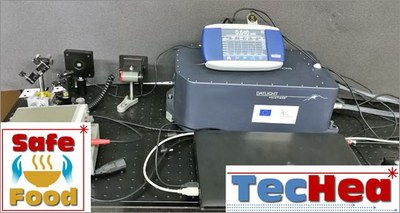Food Safety: A portable laser device detecting food fraud
4/4/2019
 ENEA takes an active role in fighting food fraud with "Safefood", a portable laser device for quick and reliable screening of the quality of food that ends up on our tables with the project "TECHEA" [1], for which ENEA has allocated 1 million euro. ENEA Frascati laboratories are working on two prototypes: one for control bodies such as the Carabinieri NAS and the other for quality control in the food industry. "Currently there are no instruments with these characteristics. Anti-fraud checks are done in the laboratory with expensive, long and complex analyses requiring specialized personnel. In our Frascati laboratories we are working to make our laser devices, instruments within the reach of those who must guarantee the quality and safety of food, from companies to large retailers to official control bodies ", Luca Fiorani of the ENEA Laboratory " Diagnostics and Metrology " and coordinator of the project, explained.
ENEA takes an active role in fighting food fraud with "Safefood", a portable laser device for quick and reliable screening of the quality of food that ends up on our tables with the project "TECHEA" [1], for which ENEA has allocated 1 million euro. ENEA Frascati laboratories are working on two prototypes: one for control bodies such as the Carabinieri NAS and the other for quality control in the food industry. "Currently there are no instruments with these characteristics. Anti-fraud checks are done in the laboratory with expensive, long and complex analyses requiring specialized personnel. In our Frascati laboratories we are working to make our laser devices, instruments within the reach of those who must guarantee the quality and safety of food, from companies to large retailers to official control bodies ", Luca Fiorani of the ENEA Laboratory " Diagnostics and Metrology " and coordinator of the project, explained.
Based on a laser technology using light and sound to detect harmful substances or substances not listed on the label, the two instruments differ according to their use: the one targeted to the food industry was designed to be integrated into the industrial process and monitor the whole production chain; the second, for inspection authorities, will be handy, easy to use and the size of a case, a mini portable laboratory where, by inserting a small sample of food, a quick and accurate screening of the presence of any contaminant will be provided in a few seconds. These features will make it suitable for fast and targeted checks in all distribution channels, from markets to supermarkets, from school canteens, hospitals and companies to small grocery stores.
"The technology behind the two anti-fraud devices is called photoacoustic laser spectroscopy. Technically, an infrared laser beam is “shot” on the sample. The sample heats up, expands and generates a pressure wave, a sort of 'echo' which is heard as sound through a microphone. In this way we can analyze any substance without its molecules being altered, and immediately obtain the results to understand if we are in the presence of food fraud ", Adriana Puiu of the ENEA Laboratory " Diagnostics and Metrology ", pointed out.
So far this technology has been tested on high consumption foods such as fish, soft drinks and fruit juices, milk powder, olive oil and wine. In the case of fish, both fresh and canned, the laser has found histamine, a toxic molecule which forms when the fish is old or poorly preserved. Since this substance is not destroyed during cooking, the only way to protect the health of consumers is to block goods before sale. In fruit juices and soft drinks the hi-tech system allows to identify the presence of five undeclared sweeteners on the label such as fructose, glucose, maltose, aspartame and sucrose; in powdered milk it can detect melamine, a substance used to manufacture plastic but capable of simulating the protein content causing serious kidney damage in newborns, while in citrus fruits it can detect pathogen infections; in extra virgin olive oil, low-cost vegetable oils and in wine substances like methanol, sulphites and ethylene glycol, the latter widely used in antifreeze liquids for automobiles.
The research that led to the invention of the anti-fraud laser stemmed from the project SAL @ CQO funded with 3 million euro by the Ministry of Economic Development with the involvement of ENEA and 6 industrial partners.
For more information please contact:
Luca Fiorani, ENEA – Laboratory "Diagnostic and Metrology", luca.fiorani@enea.it
[1] Technologies for Health: systems for applications protecting the health of citizens
